Article index
- 1 – Overview
- 2 – Gallery
- 3 – GPU information
- 4 – Benchmarks
- 4.1 – 3DMark FireStrike
- 4.2 – 3DMark TimeSpy
- 4.3 – 3DMark Port Royal
- 4.4 – 3DMark DX Raytracing Test
- 4.5 – 3DMark Speed Way
- 4.6 – Unigine Superposition
- 4.7 – FurMark
- 4.8 – Rhodium LC
- 5 – Burn-in Test
- 6 – Conclusion
1 – Overview
The Radeon RX 7900 XT and RX 7900 XTX have been launched together during December 2022 (see HERE). I reviewed the flagship RX 7900 XTX few weeks ago and today it’s the turn of the little RX 7900 XT to be reviewed.
The first thing you’ll notice with this TUF RX 7900 XT is the mass. The card is heavy, really heavy: 2.160 kg!. This card is a real tank. The weight is the consequence of the power draw of the card: more than 300W (up to 380W in some stress tests). ASUS did things seriously to chill the card and the result is a massive (3.63-slot design) and powerful Radeon card.
The RX 7900 XT is based on the Navi31 GPU (RDNA3 architecture) and packs 5376 shader processors (84 compute units) in the GPU. This TUF model has a factory-overclocked GPU: boost clock in OC mode up to 2535 MHz (RX 7900 XT reference board has a boost clock speed of 2400 MHz). The GPU has 84 ray tracing units, 336 TMUs (texturing units) and 192 ROPs. The TUF RX 7900 XT has 20GB of GDDR6 video memory and a 320-bit memory bus.
More marketing explanations and specifications can be found on the ASUS TUF RX 7900 XT homepage.
2 – Gallery
The bundle includes the following items:
– the TUF RX 7900 XT
– a certificate of reliability (military tests!)
– an installation guide
– a mobile phone holder
– a collection TUF Gaming card (in cardboard)
– a graphics card holder (the TUF RX 7900 RX is heavy…)
– a TUF velcro hook and loop
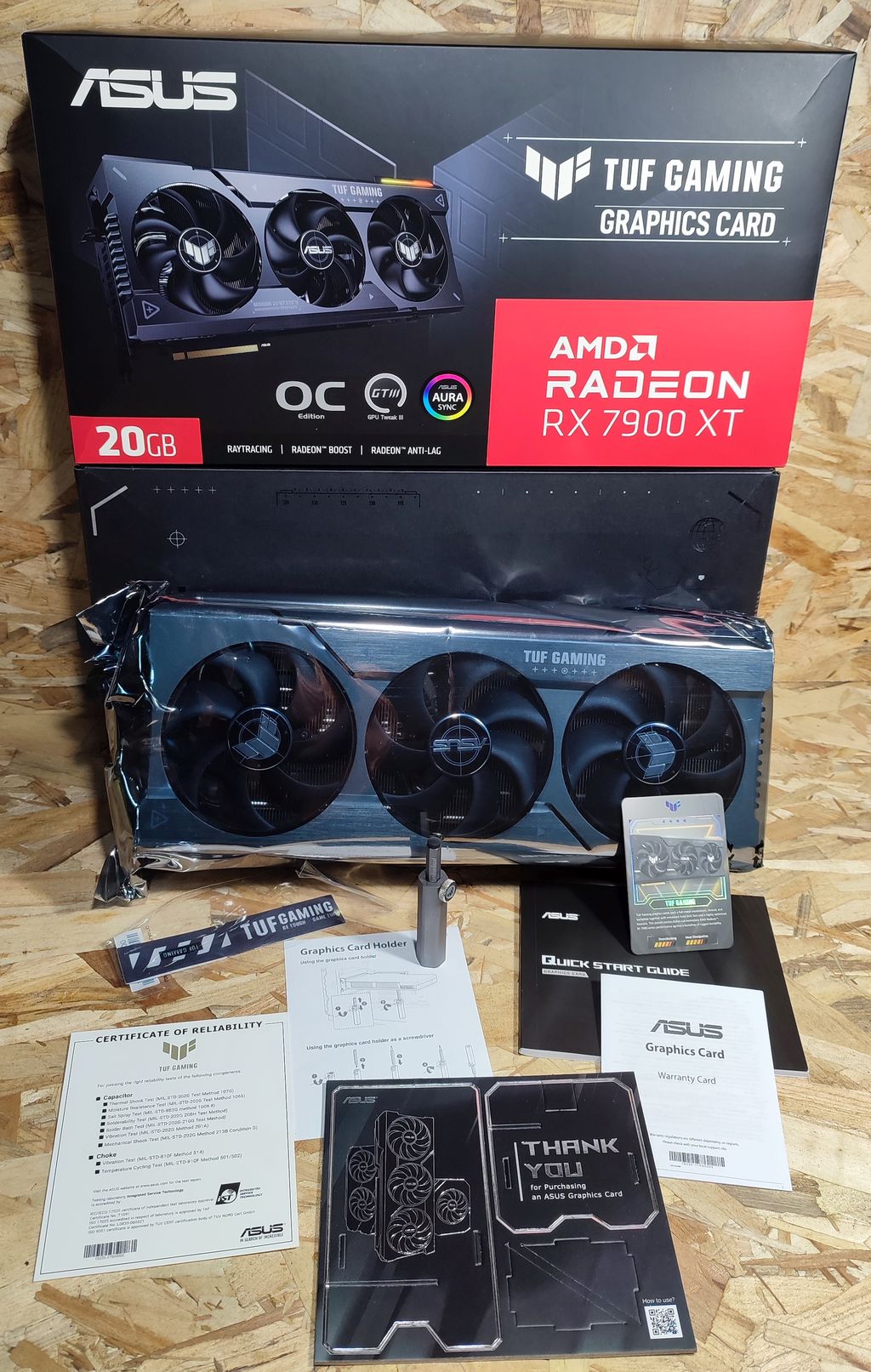
The mobile phone holder. Handy gadget, it’s easy to mount and is stable. Now my phone has a real place in the mess of my desk.
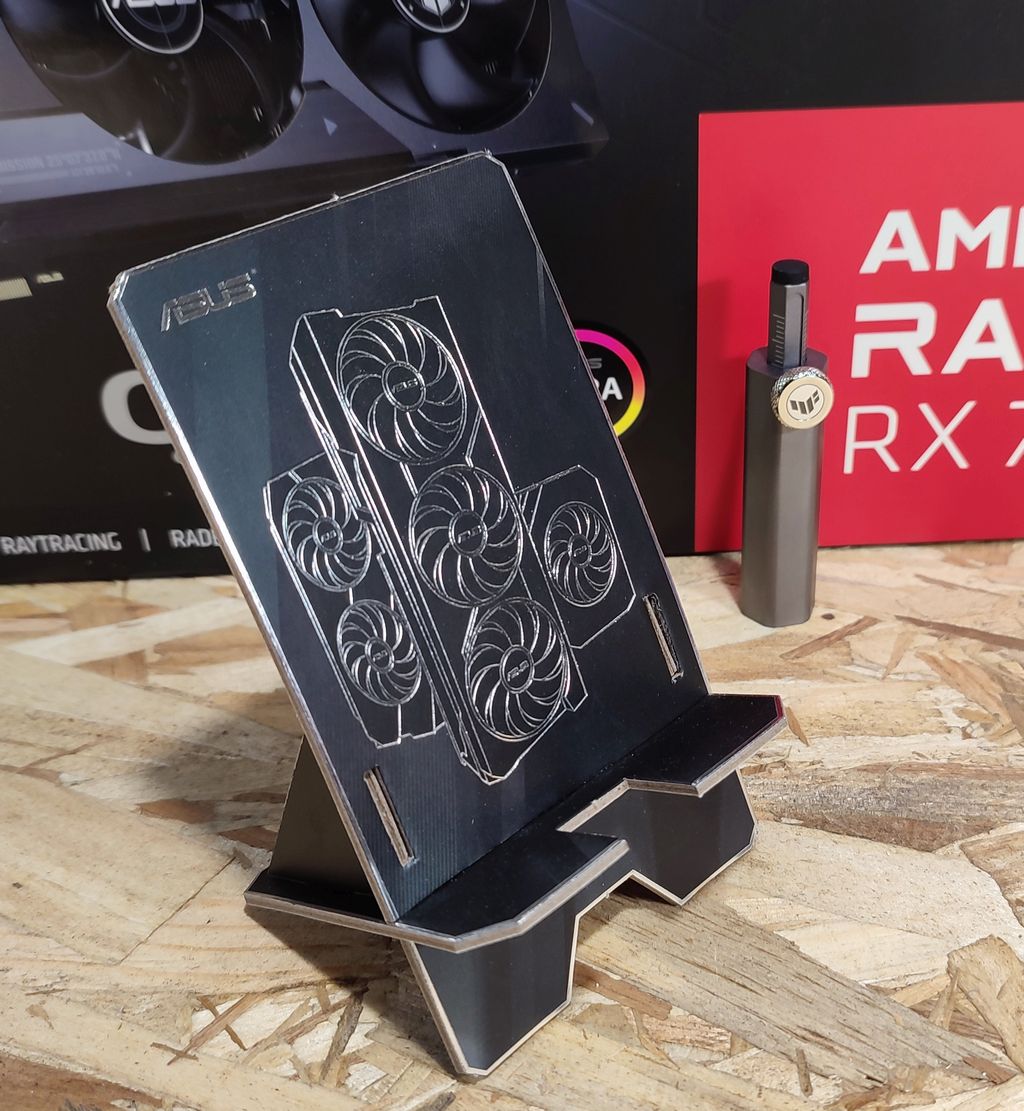
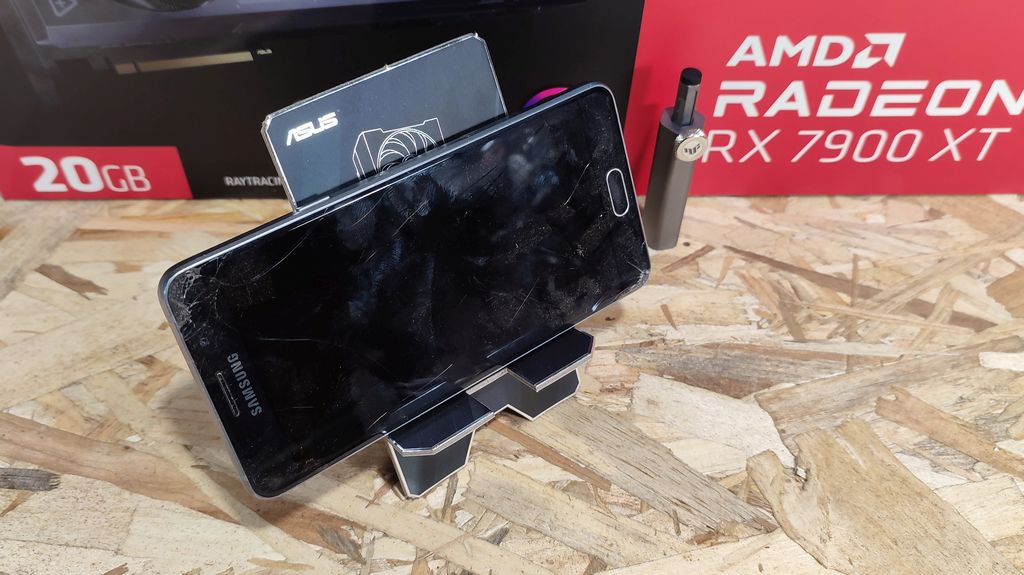
The graphics card holder. When mounting horizontally in a case, this gadget is useful to support the mass of the TUF RX 7900 XT: 2.160 kg. Thanks to the screw, you can tune the height of the holder.
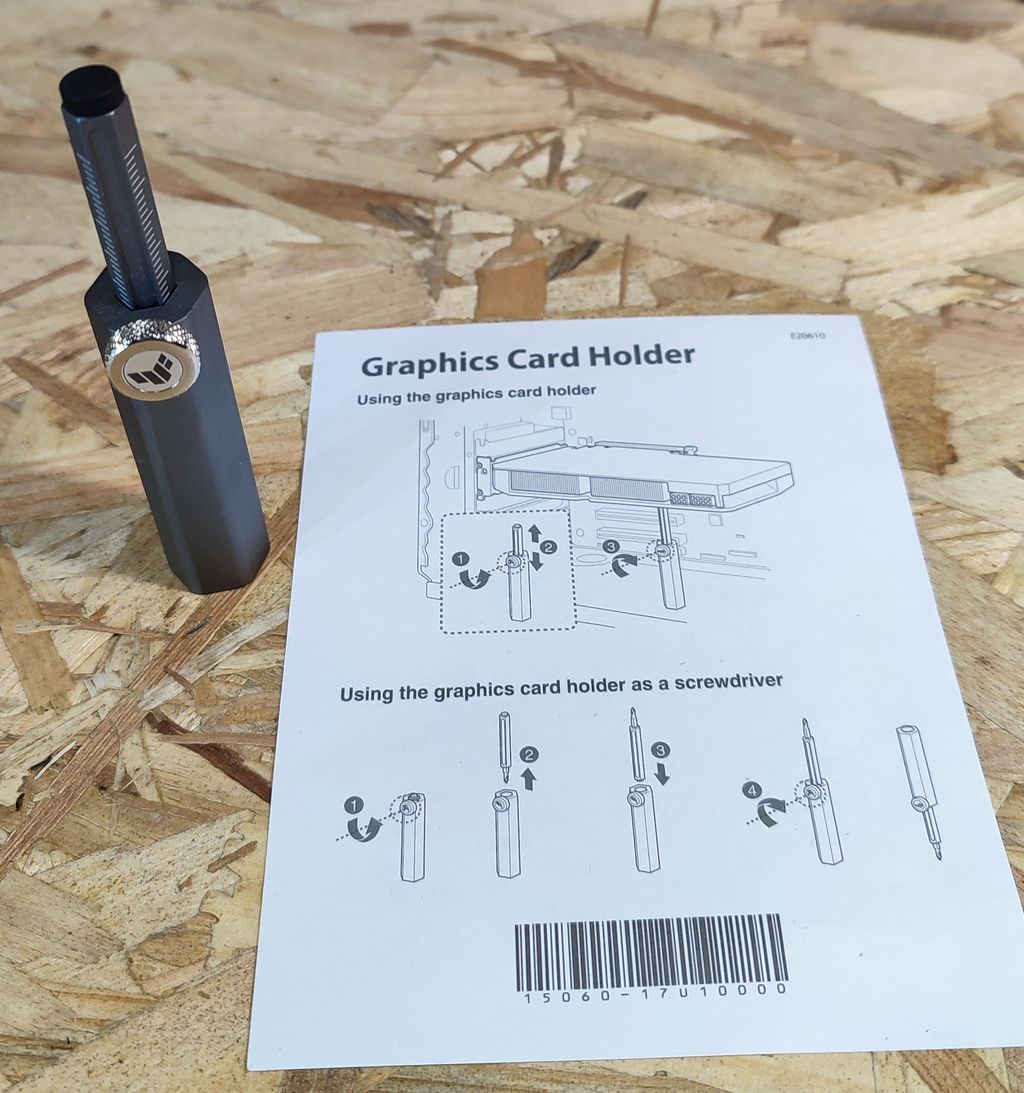
The graphics card with a 3.6-slot design. I really love the industrial look of the card (the design is nearly the same than the one of the RTX 4070 Ti).

The VGA cooler has three 10.5-cm fans. These fans are stopped in idle / light workload and spin when workload is higher:
The two side fans spin counterclockwise to minimize turbulence and maximize air dispersion through the heatsink. All three fans come to a standstill when GPU temps are below 55 Celsius, letting you play less-demanding games or perform light tasks in relative silence. Fans start up again when temps are over 60 Celsius, referencing a speed curve that balances performance and acoustics for work or play.

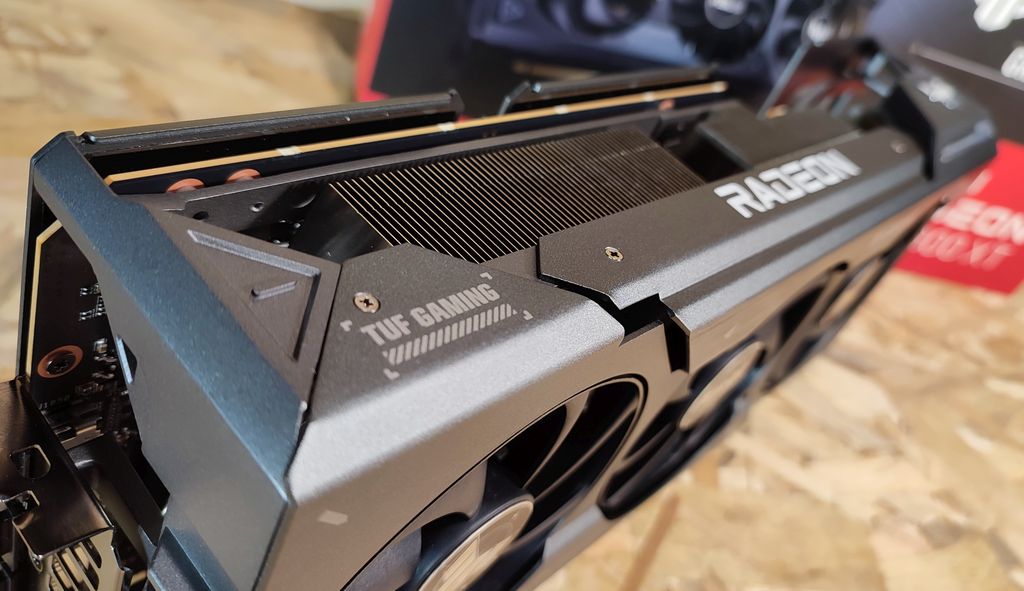

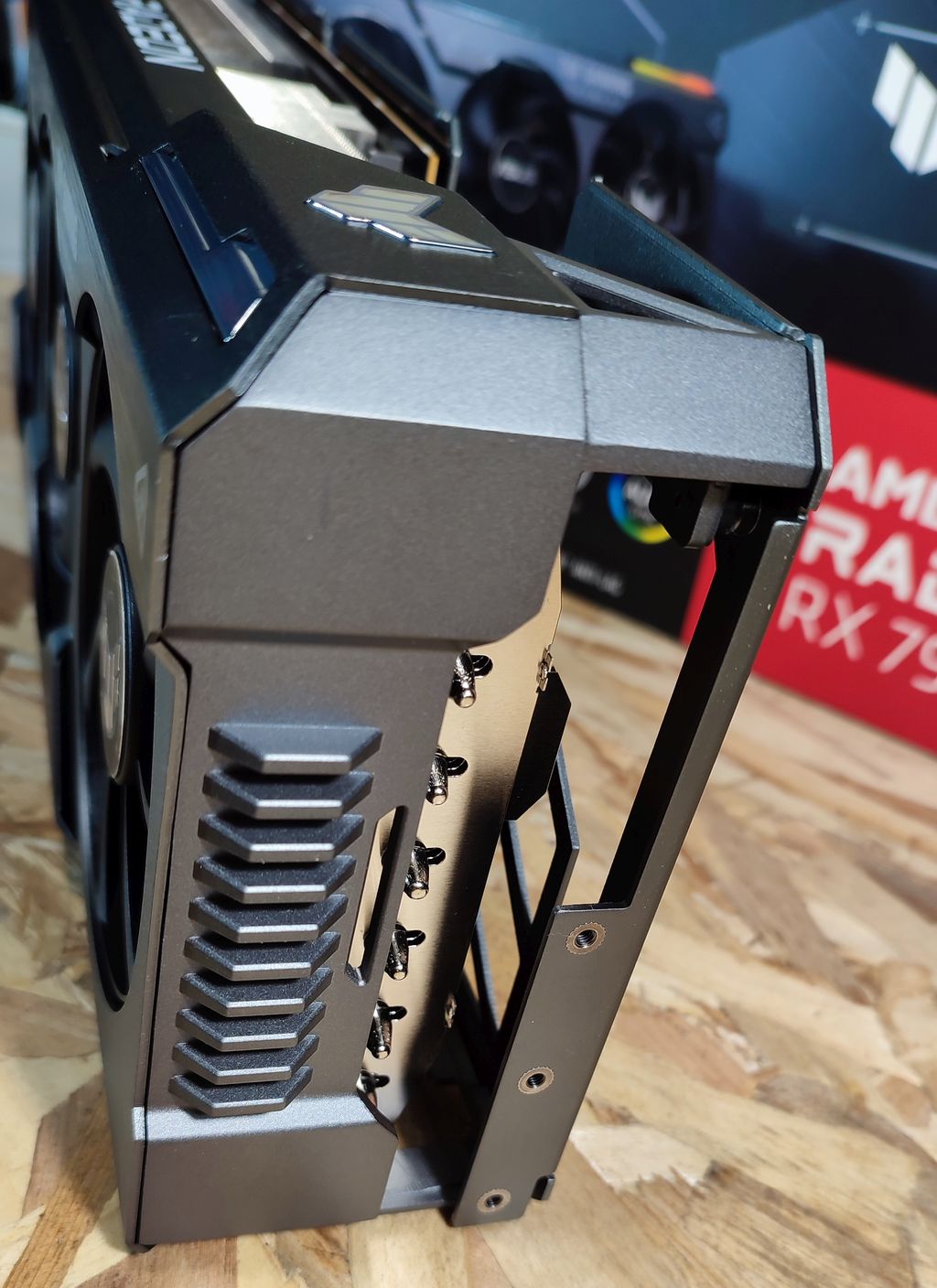
Output connectors: one HDMi 2.1 (up to 4k @ 240Hz or 8k @ 60Hz) and three DisplayPort 2.1 (up to 16k @ 60Hz or 8k @ 120Hz).
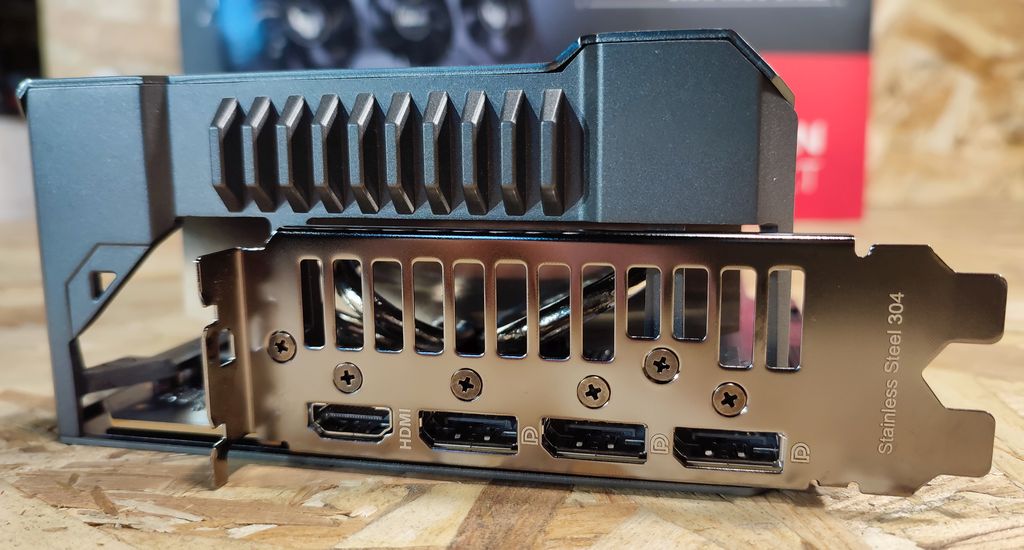
The aluminum backplate.
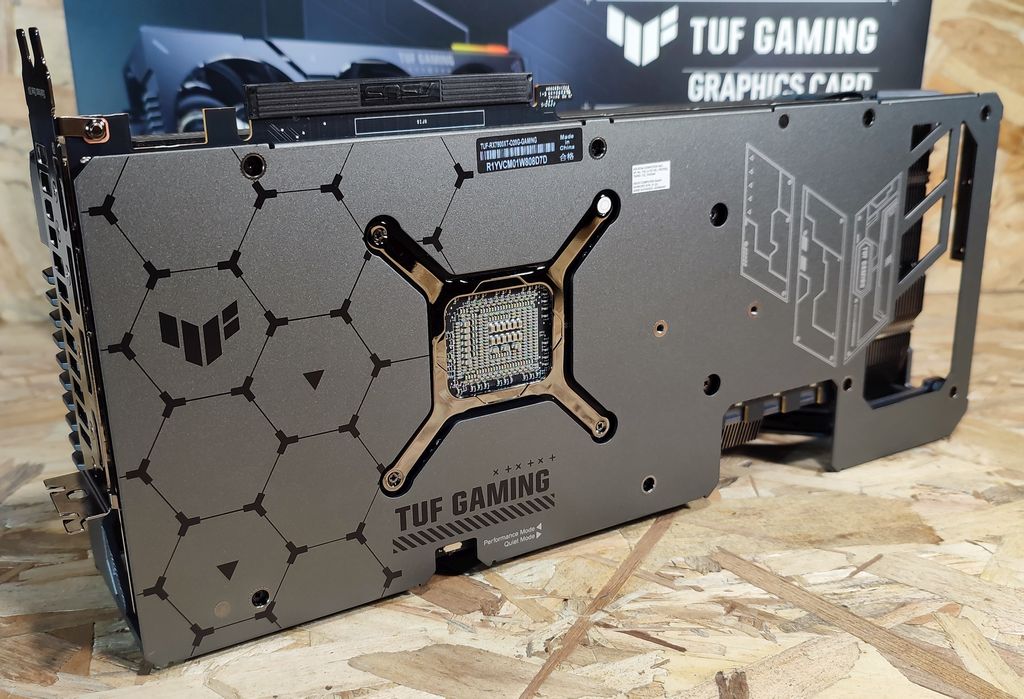
The dual-bios switch. Default position is on Performance mode.
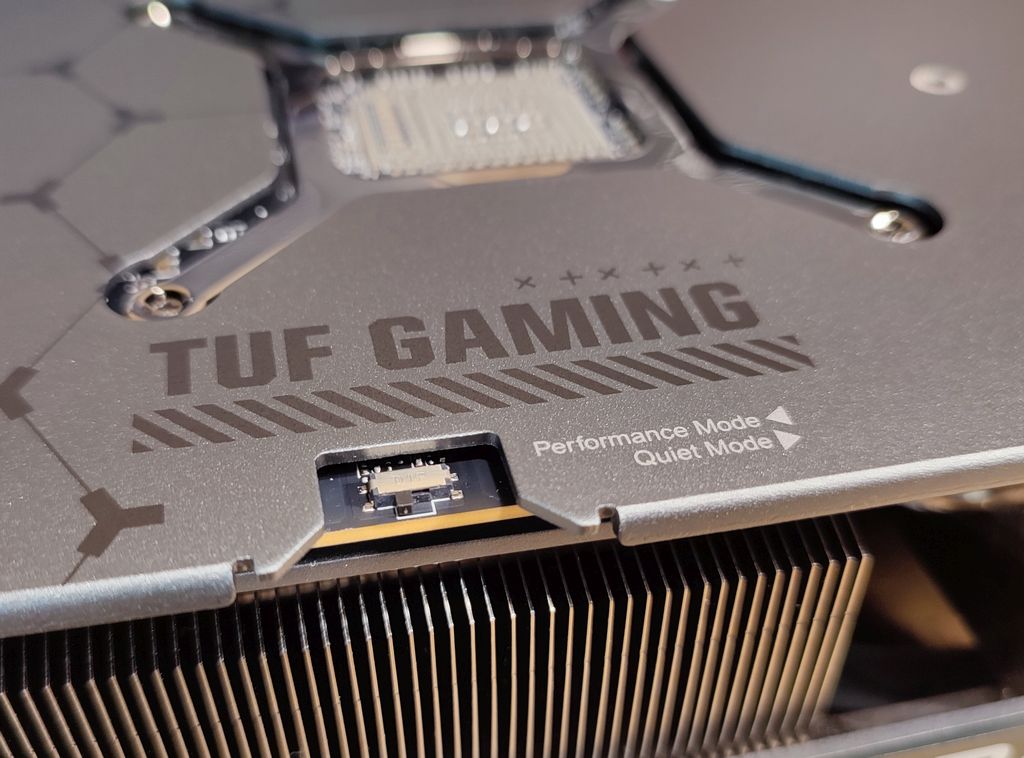
The 3 x 8-pin power connectors (3x150W = 450W). If we add the 75W of the PCI-E slot, the total board power can support up to 525W. But I don’t know if the power circuitry of the TUF RX 7900 XT can handle such a power. A LED near each connector indicates the correct working of the connector (the voltage is ok!).

The ARGB lighting (that can be controlled by AURA compatible software):
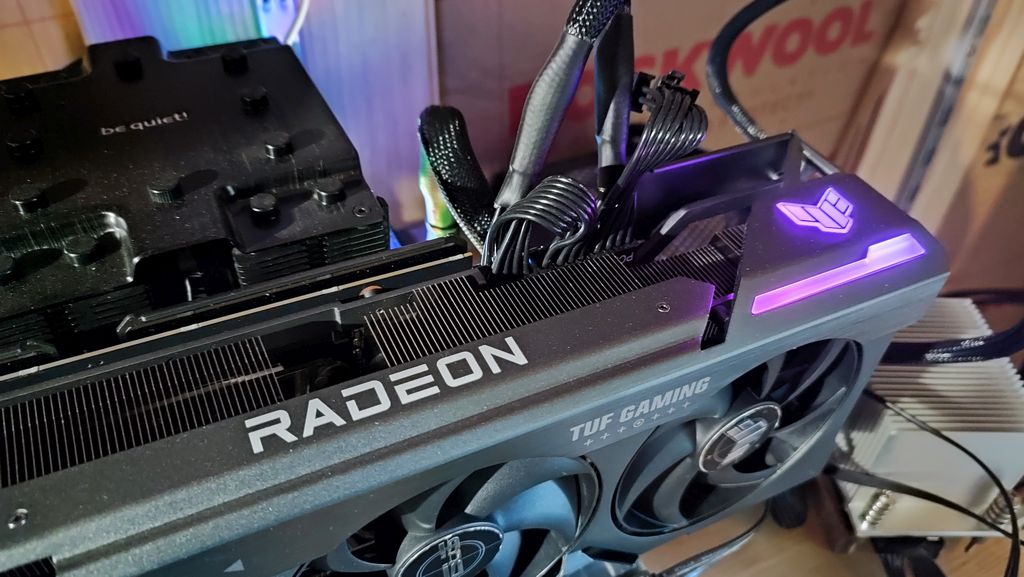
3 – GPU Information
GPU data from the new GPU Shark 2:
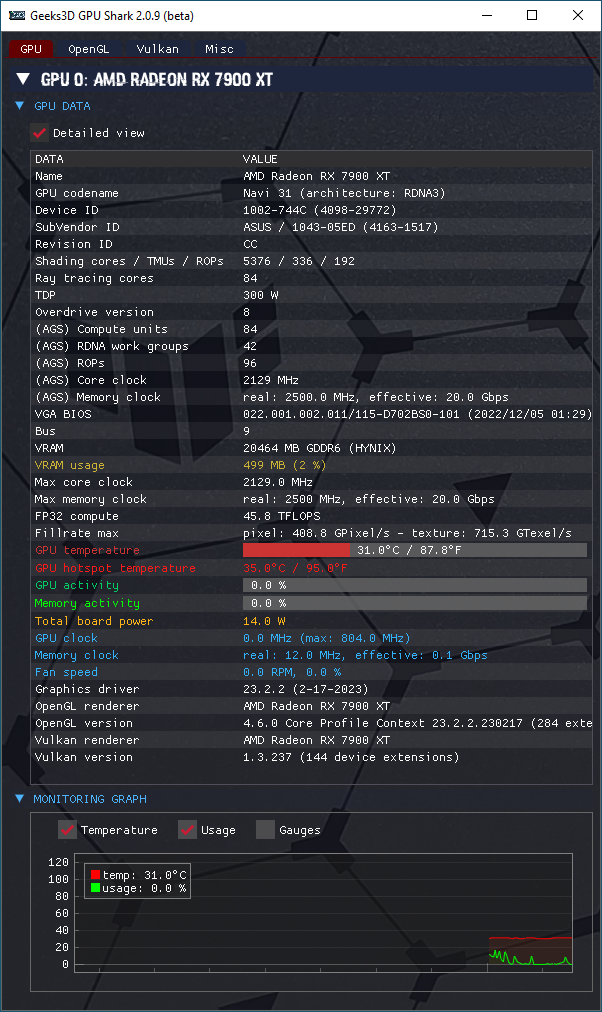
GPU-Z screenshots.
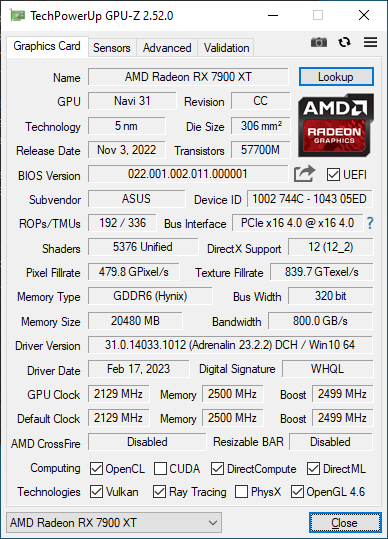

4 – GPU Benchmarks
| Arc A380 Test System 2 | |
|---|---|
| CPU | AMD Ryzen 7 5800X |
| Motherboard | ASUS TUF X570-Plus |
| Memory | 16GB DDR4 Corsair Vengeance LED @ 3200MHz |
| PSU | Corsair RM1000x |
| Storage | Samsung 860 EVO 1TB SSD |
| Monitor | ASUS TUF VG289Q 4K |
| OS | Windows 10 22H2 64-bit |
| Graphics driver | Adrenalin 23.2.2 |
4.1 – 3DMark FireStrike
Fire Strike is a DirectX 11 benchmark for high-performance gaming PCs and overclocked systems. Fire Strike is very demanding, even for the latest graphics cards. If your frame rate is low, use Sky Diver instead.
Graphics test 1 has heavy tessellation and volumetric illumination. Graphics test 2 features complex smoke simulation using compute shaders on the GPU and dynamic particle illumination.
The Physics test runs 32 parallel simulations of soft and rigid body physics on the CPU.
The Combined test includes tessellation, illumination, smoke simulation and particles and post-processing on the GPU, while the CPU is tasked with running 32 parallel physics simulations.
Firestrike has a global score and three sub-scores (graphics, physics and combined). For this test, I compare the graphics score only.
| 77375 SAPPHIRE Nitro+ Radeon RX 7900 XTX 24GB – Adrenalin 23.1.2 |
| 69209 ASUS TUF Radeon RX 7900 XT 20GB – Adrenalin 23.2.2 |
| 53903 ASUS TUF RTX 4070 Ti 12GB OC – GeForce 528.49 |
| 48432 ASUS TUF Radeon RX 6800 XT OC 16GB – Adrenalin 20.12.2 |
| 31431 Intel Arc A750 LE – Intel 31.0.101.3793 – Resizable BAR: ON |
| 29130 GIGABYTE GeForce RTX 3060 Ti Gaming OC 8G – GeForce 460.79 |
| 13079 EVGA GeForce GTX 1060 SC 6GB – GeForce 416.94 |
| 11368 MSI GeForce GTX 970 – GeForce 416.94 |
| 9402 ASRock Arc A380 – Intel 31.0.101.3491 |
| 8616 MSI Radeon HD 7970 – Adrenalin 18.11.1 |
4.2 – 3DMark TimeSpy
Time Spy is a DirectX 12 benchmark with native support for new API features like asynchronous compute, explicit multi-adapter, and multi-threading.
Time Spy Graphics tests are rendered at 2560 × 1440 resolution.Graphics test 1 features lots of transparent content, particle shadows, and tessellation. Graphics test 2 features ray-marched volumetric illumination
with hundreds of lights and a large number of small particles.
Same thing, I took the graphics score only.
| 29930 SAPPHIRE Nitro+ Radeon RX 7900 XTX 24GB – Adrenalin 23.1.2 |
| 25869 ASUS TUF Radeon RX 7900 XT 20GB – Adrenalin 23.2.2 |
| 22263 ASUS TUF RTX 4070 Ti 12GB OC – GeForce 528.49 |
| 16294 ASUS TUF Radeon RX 6800 XT OC 16GB – Adrenalin 20.12.2 |
| 12264 Intel Arc A750 LE – Intel 31.0.101.3793 – Resizable BAR: ON |
| 10837 GIGABYTE GeForce RTX 3060 Ti Gaming OC 8G – GeForce 460.79 |
| 10415 ASUS ROG Strix GeForce RTX 2080 OC 8GB – GeForce 460.89 |
| 8461 MSI GeForce RTX 2070 Ventus 8GB – GeForce 417.01 |
| 4776 SAPPHIRE Radeon RX 5500 XT Pulse – Adrenalin 20.01.3 |
| 4334 ASRock Arc A380 – Intel 31.0.101.3491 – Resizable BAR: OFF |
| 4301 ASRock Arc A380 – Intel 31.0.101.3491 – Resizable BAR: ON |
| 4244 EVGA GeForce GTX 1060 SC 6GB – GeForce 416.94 |
| 753 Intel UHD Graphics 770 – Intel 31.0.101.1371 |
4.3 – 3DMark Port Royal
Port Royal is a graphics card benchmark for testing real-time ray tracing performance. To run this test, you must have a graphics card and drivers that support Microsoft DirectX Raytracing.
The test measures graphics card performance with a combination of real-time ray tracing and traditional rendering techniques. The scene features ray traced reflections, shadows (ray traced and shadow mapped), glass surfaces with ray traced reflections, volumetric lighting, particles, and post-processing effects. The rendering resolution is 2560 × 1440.
| 15816 SAPPHIRE Nitro+ Radeon RX 7900 XTX 24GB – Adrenalin 23.1.2 |
| 13889 ASUS TUF Radeon RX 7900 XT 20GB – Adrenalin 23.2.2 |
| 13859 ASUS TUF RTX 4070 Ti 12GB OC – GeForce 528.49 |
| 9149 ASUS TUF Radeon RX 6800 XT OC 16GB – Adrenalin 20.12.2 |
| 6916 GIGABYTE GeForce RTX 3060 Ti Gaming OC 8G – GeForce 460.79 |
| 6512 Intel Arc A750 LE – Intel 31.0.101.3793 – Resizable BAR: ON |
| 6863 ASUS ROG Strix GeForce RTX 2080 OC 8GB – GeForce 460.89 |
| 745 ASRock Arc A380 – Intel 31.0.101.3491 – Resizable BAR: ON |
| 666 ASRock Arc A380 – Intel 31.0.101.3491 – Resizable BAR: OFF |
4.4 – 3DMark DX Raytracing Test
The DirectX Raytracing feature test measures pure ray-tracing performance. Use this test to compare the performance of dedicated ray-tracing hardware in the latest graphics cards.
In this feature test, there is a minimal amount of traditional rendering. The result of the test depends entirely on the ray-tracing performance of the graphics card.
Instead of using traditional rendering, the whole scene is ray-traced and drawn in one pass. Camera rays are traced across the field of view with small random offsets to simulate a depth of field effect. The frame rate is determined by the time taken to trace and shade a set number of samples for each
pixel (12 samples per pixel), combine the results with previous samples and present the output on the screen. The rendering resolution is 2560 × 1440.

| 66.85 ASUS TUF RTX 4070 Ti 12GB OC – GeForce 528.49 |
| 51.86 SAPPHIRE Nitro+ Radeon RX 7900 XTX 24GB – Adrenalin 23.1.2 |
| 43.7 ASUS TUF Radeon RX 7900 XT 20GB – Adrenalin 23.2.2 |
| 28.78 FPS Intel Arc A750 LE – Intel 31.0.101.3793 – Resizable BAR: ON |
| 27.43 GIGABYTE GeForce RTX 3060 Ti Gaming OC 8G – GeForce 522.25 |
| 25.25 FPS ASUS TUF Radeon RX 6800 XT OC 16GB – Adrenalin 22.10.1 |
| 21.5 FPS ASUS ROG Strix GeForce RTX 2080 OC 8GB – GeForce 522.25 |
| 9 FPS ASRock Arc A380 – Intel 31.0.101.3491 |
4.5 – 3DMark Speed Way
3DMark Speed Way is a graphics card benchmark for testing DirectX 12 Ultimate performance. To run this test, you must have a graphics card that supports DirectX 12 Ultimate and has 6GB or more of video memory.
Graphics test: the test measures graphics card performance with a combination of real-time ray tracing and traditional rendering techniques. The scene features ray traced reflections, real time global illumination, mesh shaders, volumetric lighting, particles and post-processing effects. The rendering resolution is 2560 × 1440.

| 6294 SAPPHIRE Nitro+ Radeon RX 7900 XTX 24GB – Adrenalin 23.1.2 |
| 5374 ASUS TUF RTX 4070 Ti 12GB OC – GeForce 528.49 |
| 5121 ASUS TUF Radeon RX 7900 XT 20GB – Adrenalin 23.2.2 |
| 3433 (avg FPS: 34) ASUS TUF Radeon RX 6800 XT OC 16GB – Adrenalin 22.10.1 |
| 2970 (avg FPS: 29) GIGABYTE GeForce RTX 3060 Ti Gaming OC 8G – GeForce 522.25 |
| 2320 (23.2 FPS) Intel Arc A750 LE – Intel 31.0.101.3793 – Resizable BAR: ON |
| 2168 (avg FPS: 21) ASUS ROG Strix GeForce RTX 2080 OC 8GB – GeForce 522.25 |
| 434 (avg FPS: 4) ASRock Arc A380 6GB – Resizable BAR: ON – Intel 31.0.101.3491 |
| 375 (avg FPS: 3) ASRock Arc A380 6GB – Resizable BAR: OFF – Intel 31.0.101.3491 |
4.6 – Unigine Superposition – 1080p Medium – Direct3D
| 38879 (avg FPS: 290) SAPPHIRE Nitro+ Radeon RX 7900 XTX 24GB – Adrenalin 23.1.2 |
| 37727 (avg FPS: 282) ASUS TUF Radeon RX 7900 XT 20GB – Adrenalin 23.2.2 |
| 37445 (avg FPS: 280) ASUS TUF RTX 4070 Ti 12GB OC – GeForce 528.49 |
| 21154 (avg FPS: 175) GIGABYTE GeForce RTX 3060 Ti Gaming OC 8G – GeForce 460.79 |
| 20985 (avg FPS: 157) ASUS TUF Radeon RX 6800 XT OC 16GB – Adrenalin 20.12.2 |
| 20923 (156 FPS) Intel Arc A750 LE – Intel 31.0.101.3793 – Resizable BAR: ON |
| 9082 (avg FPS: 67.9) EVGA GeForce GTX 1060 SC 6GB – GeForce 416.94 |
| 7166 (avg FPS: 53) ASRock Arc A380 – Intel 31.0.101.3491 – Resizable BAR: ON |
| 6141 (avg FPS: 46) ASRock Arc A380 – Intel 31.0.101.3491 – Resizable BAR: OFF |
4.7 – FurMark 1.33
FurMark is a very intensive graphics benchmark and does not depend on the processing power of the CPU. So FurMark is a quick way to have an overview of the graphics performances of a GPU.
P1080 (1920×1080)
| 27719 (453 FPS) SAPPHIRE Nitro+ Radeon RX 7900 XTX 24GB – Adrenalin 23.1.2 |
| 24052 (401 FPS) ASUS TUF RTX 4070 Ti 12GB OC – GeForce 528.49 |
| 21713 (avg FPS: 362) ASUS TUF Radeon RX 7900 XT 20GB – Adrenalin 23.2.2 |
| 17507 (avg FPS: 292) ASUS TUF Radeon RX 6800 XT OC 16GB – Adrenalin 20.12.2 |
| 10530 (avg FPS: 175) GIGABYTE GeForce RTX 3060 Ti Gaming OC 8G – GeForce 460.79 |
| 10137 (169 FPS) Intel Arc A750 LE – Intel 31.0.101.3793 – Resizable BAR: ON |
| 7322 (avg FPS: 122) ASUS ROG Strix GeForce GTX 1080 OC 8GB – GeForce 416.94 |
| 4556 (avg FPS: 76) EVGA GeForce GTX 1060 SC 6GB – GeForce 416.94 |
| 4475 (avg FPS: 75) SAPPHIRE Radeon RX 5500 XT Pulse – Adrenalin 20.01.3 |
| 3246 (avg FPS: 54) MSI Radeon HD 7970 – Adrenalin 18.11.1 |
| 3036 (avg FPS: 50) ASRock Arc A380 – Intel 31.0.101.3491 – Resizable BAR: ON |
| 2969 (avg FPS: 49) ASRock Arc A380 – Intel 31.0.101.3491 – Resizable BAR: OFF |
| 714 (avg FPS: 12) Intel UHD Graphics 770 – Intel 31.0.101.1371 |
4.8 – Rhodium LC
Rhodium LC (LC for Liquid Carbon!) is a new GPU pixel shader benchmark made with GeeXLab and based on this shadertoy demo. You can download RhodiumLC from THIS PAGE.

P1080 (1920×1080)
| 17026 (283 FPS) SAPPHIRE Nitro+ Radeon RX 7900 XTX 24GB – Adrenalin 23.1.2 |
| 12386 (206 FPS) ASUS TUF Radeon RX 7900 XT 20GB – Adrenalin 23.2.2 |
| 8721 (145 FPS) ASUS TUF RTX 4070 Ti 12GB OC – GeForce 528.49 |
| 6189 (103 FPS) Intel Arc A750 LE – Intel 31.0.101.3793 – Resizable BAR: ON |
| 5740 (avg FPS: 95) ASUS TUF Radeon RX 6800 XT OC 16GB – Adrenalin 20.12.2 |
| 4853 (avg FPS: 80) ASUS ROG Strix GeForce RTX 2080 OC 8GB – GeForce 416.94 |
| 4094 (avg FPS: 68) GIGABYTE GeForce RTX 3060 Ti Gaming OC 8G – GeForce 526.98 |
| 2835 (avg FPS: 47) EVGA GeForce GTX 1070 FTW – GeForce 416.94 |
| 2773 (avg FPS: 46) ASUS Strix Radeon RX 5700 – Adrenalin 20.12.2 |
| 1923 (avg FPS: 32) EVGA GeForce GTX 1060 SC 6GB – GeForce 416.94 |
| 1755 (avg FPS: 29) SAPPHIRE Radeon RX 5500 XT Pulse – Adrenalin 20.01.3 |
| 1719 (avg FPS: 28) ASRock Arc A380 – Intel 31.0.101.3491 |
| 1484 (avg FPS: 24) MSI GeForce GTX 970 – GeForce 416.94 |
| 1192 (avg FPS: 19) MSI Radeon RX 470 8GB – Adrenalin 18.11.1 |
| 303 (avg FPS: 5) Intel UHD Graphics 770 – Intel 31.0.101.1371 |
5 – Burn-in Test
The burn-in test has been done with the new version of FurMark 2 (beta version available on discord). This version of FurMark is 64-bit and uses OpenGL or Vulkan API. I used the OpenGL version for the stress test. I did two stress tests: the first one with the power limit target set to 100% (default mode in ASUS GPU Tweak III) and the second one set to +115% (OC mode in GPU Tweak).
During both stress tests, the BIOS switch was on the position 1 (max performance).
Idle state
– total power consumption of the testbed: 62W
– GPU temperature: 23°C
– total graphics card: 17W
– GPU clock: 15 MHz
Stress test 1 – Default mode – GPU Power set to 100%, GPU clock: 2780 MHz
– total power consumption of the testbed: 445W
– GPU temperature: 57°C (hotspot: 69°C)
– total graphics card: 331W
– GPU clock: 1750 MHz
Stress test 2 – OC mode – GPU Power set to 115%, GPU clock: 2800 MHz
– total power consumption of the testbed: 504W
– GPU temperature: 57°C (hotspot: 73°C)
– total graphics card: 385W
– GPU clock: 1975 MHz
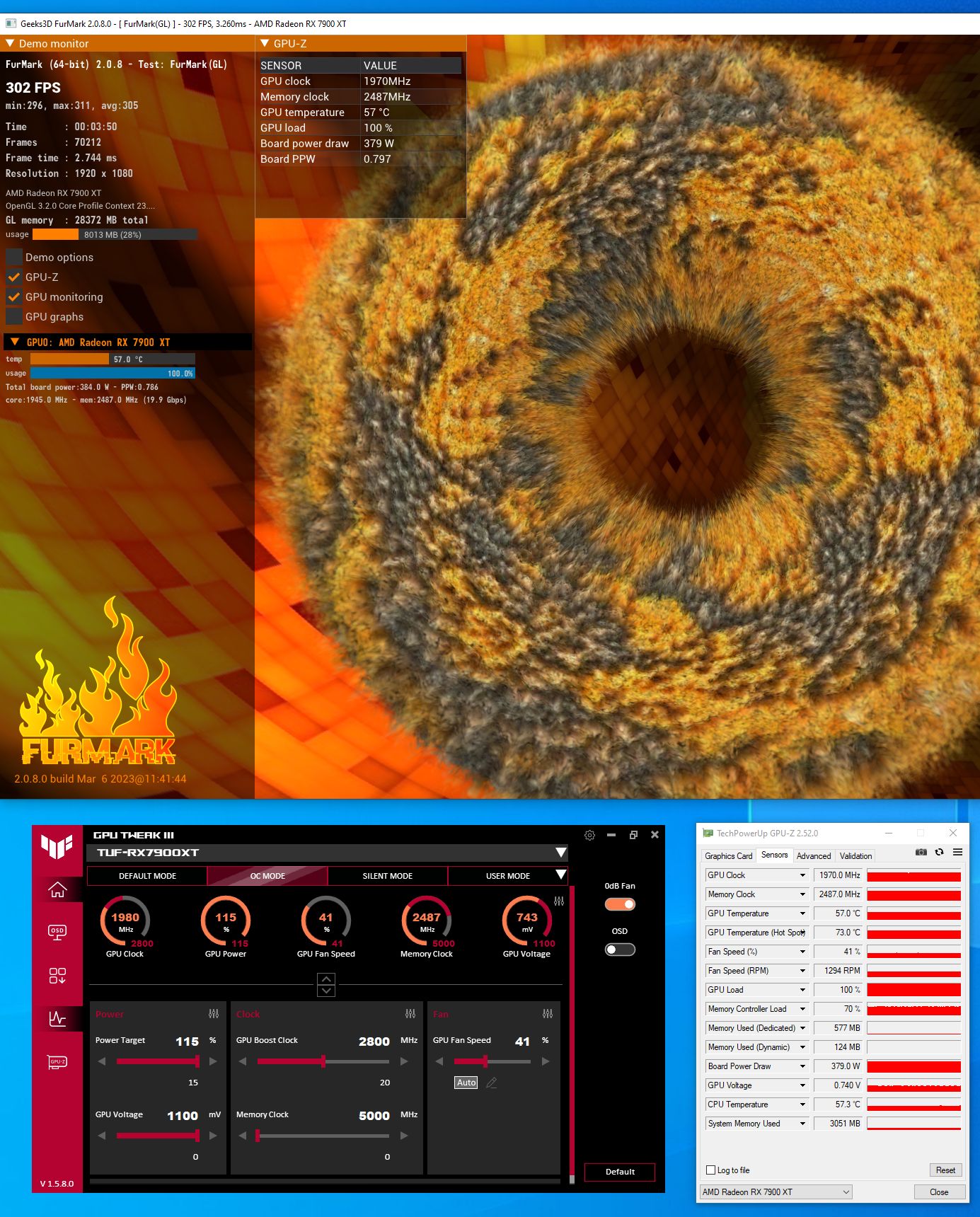
Even in OC mode under FurMark, the fans are quiet. The VGA cooler does a very good job by keeping silently the GPU temperature under control: 57°C was the max reached.
6 – Conclusion
Here are pros and cons of this graphics card:
PROS:
- industrial look, AURA lighting
- ASUS GPU Tweak
- factory overclocked
- lot of processing power (like the 7900 XTX, see the RhodiumLC test)
- gadgets: mobile phone holder, graphics card holder
- passive mode in idle and light graphics workload
- HDMI 2.1 and DisplayPort 2.1 ports
- very efficient and quiet VGA cooler
- power consumption at idle: 14W
- lot of VRAM (20GB)
CONS:
- mass: more than 2 kg!
The TUF RX 7900 XT is a fantastic card. Ok the card is massive but to dissipate 380W, the VGA cooler must be bulky (and heavy!). So check the size of your case before buying this card (the length of the card: 35cm). The card is fast and quiet. The power draw at idle is low (14W, same value than the 7900 XTX) but here, NVIDIA is better with less than 4W at idle (see the RTX 4070 Ti test).
For graphics developers, the RX 7900 XT (and XTX) supports the same OpenGL and Vulkan features than previous gen RX 6800 / 6900. The RX 7900 XT has the same number of OpenGL extensions and the same number of Vulkan device extensions than a RX 6800 XT. This is the state today but it may change in the future, especially with Vulkan.
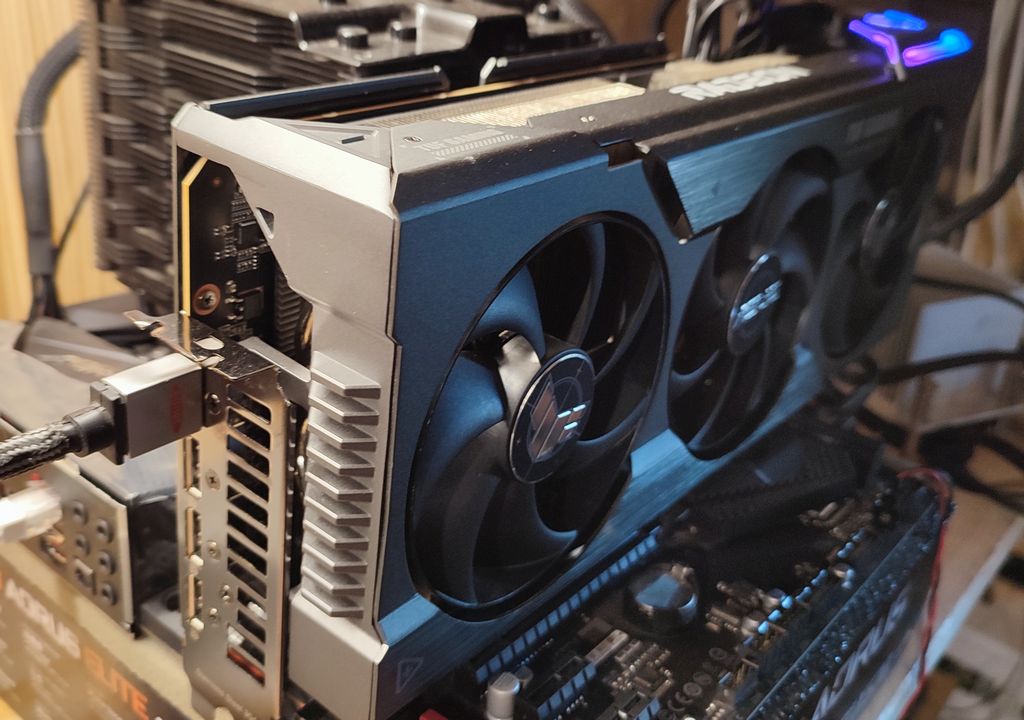

I just purchased same card TUF RX9700XT it is noisy as hell. I was about to replace my TUF RTX3070Ti with this model but both cards spin fans as crazy. RX is even noisier. I want product that is not annoying during game play. Cannot measure RPM because I found no way to read the data, it shows 0rpm in most apps and Asus app just gives you percentage. This is really a serious problem and I’d like to use card without need to change settings/undervoltage/fan throttling.